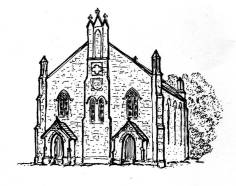| The
Non Conformists Chapels in the Glasbury Area
This article was prepared by M. A. V. Gill in 2005 for the "Glasbury Book" (unpublished), It was first published with annotations in Brycheiniog Vol XVIII 2012 . The excellent artwork is also by the same local author |
NONCONFORMIST CHAPELS AND MEETINGHOUSES In a period when so many Nonconformist chapels throughout Wales are being made redundant and demolished or converted to secular use, no fewer than three in the parish of Glasbury appear in Anthony Jones’ monograph Welsh Chapels (1984), listed as buildings which should be “saved at all costs”: Maesyronen, Capel-y-ffin and Treble Hill, each representative of a different period and style of chapel building. In J.W. Hobbs’ reminiscences, he describes the Chapel Sunday school Anniversaries as great events, when children and adults would give songs and recitations: “One year a grand ‘Dialogue’ was given by the men of the Chapel. It was called ‘Noah’s Ark’ and the part of the patriarch was taken by the white haired old stationmaster, Mr. Jones. There were about a dozen men and boys taking part, but the only two names I remember were a Mr. Holder and the jovial old Precentor, Mr. James Morgan, who added a touch of humour by rushing in, getting stage fright and instead of the grandiloquent speech he should have delivered, looking blankly around and then blurting out, ‘the river has ruz, and I’m feared as most of my ships have been washed away’. I was a sinner who repented and arrived after Noah had entered the Ark (the Chapel vestry), and heard the solemn words from inside ‘Too late, too late, the door is shut, you cannot enter now!’”. GLASBURY UNITED REFORM MEMORIAL CHAPEL Source : -- "A Chapter on the Churches and Chapels in the Parish of Glasbury " by M.A.V. Gill
|
 During
a visit of the Rev. Newman Hall to Maesyronen, a service was held
in a large tent pitched on Glasbury village green, and the building
of a chapel in the village was mooted, for the old chapel was “too
much after its own day to suit modern worshippers” besides
being “somewhat inconveniently situated”. At a conference
held at Maesyronen on 25th March 1863 to consider the necessity
of erecting a new chapel, it was resolved unanimously that immediate
steps should be taken and a committee formed for this purpose. A
building fund was started and a grant of £150 obtained from
Samuel Morley, who was offering sums of money towards the erection
of a certain number of Congregational chapels during a given period,
such chapels to be known as Memorials of the Bicentenary Celebration
of the Ejection of 1662. Plans were draughted by the famous chapel
designer, the Rev. Thomas Thomas of Glandwr; a site was secured
and, after some delay, work began. The builder of the modified Gothic
edifice was Edward Powell of Hay. Much of the stone was quarried
locally at Cwmbach, while the dressing stone came from Dolerw quarry,
and the cresting tiles on the slate roof were from Broseley.
During
a visit of the Rev. Newman Hall to Maesyronen, a service was held
in a large tent pitched on Glasbury village green, and the building
of a chapel in the village was mooted, for the old chapel was “too
much after its own day to suit modern worshippers” besides
being “somewhat inconveniently situated”. At a conference
held at Maesyronen on 25th March 1863 to consider the necessity
of erecting a new chapel, it was resolved unanimously that immediate
steps should be taken and a committee formed for this purpose. A
building fund was started and a grant of £150 obtained from
Samuel Morley, who was offering sums of money towards the erection
of a certain number of Congregational chapels during a given period,
such chapels to be known as Memorials of the Bicentenary Celebration
of the Ejection of 1662. Plans were draughted by the famous chapel
designer, the Rev. Thomas Thomas of Glandwr; a site was secured
and, after some delay, work began. The builder of the modified Gothic
edifice was Edward Powell of Hay. Much of the stone was quarried
locally at Cwmbach, while the dressing stone came from Dolerw quarry,
and the cresting tiles on the slate roof were from Broseley.